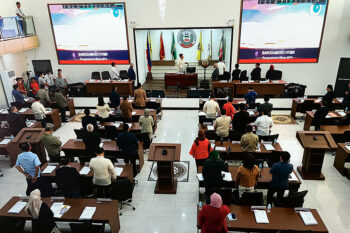GENERAL SANTOS CITY (MindaNews / 16 Oct) – Philippine Daily Inquirer(October 14, 2014: Palace questions poll on ‘daang matuwid’) reported, “Malacañang on Monday refused to accept that 36 percent of Filipinos believed that President Aquino had failed to deliver on his promise to lead the country toward ‘daang matuwid’ (straight path).” This is according to the September 8 to 15 survey of Pulse Asia released last Monday.
The 1,200 poll respondents were asked to respond to the statement, “President Aquino has fulfilled his promise to follow a straight path,” with “Agree”, “Undecided” or “Disagree”. In the news report, “undecided” is referred to as “ambivalent”.
Nationwide, public opinion was almost equally split: “Agree”, 29 percent; “Undecided”, 34 percent; and, “Disagree”, 36 percent – with “a margin of error of plus-or-minus 3 percentage points at the 95-percent confidence level”.
There is almost the same three-way split in Metro Manila, the Rest of Luzon, the Visayas and Mindanao and among the socioeconomic Classes ABC, D and E. But in the rest of Luzon, “Disagree” dominated, 45 percent with “Agree” and “Undecided” significantly disparate, 22 to 33; in the Visayas, “Undecided” dominated, 43 percent; in Mindanao, “Agree” dominated, 43 percent; in Class ABC, “Disagree” dominated, 43 percent with the “Agree” and ”Undecided” significantly disparate, 33 to 24.
Lacierda Objected
Presidential spokesman Edwin Lacierda rejected “the idea that Filipinos were not satisfied with Aquino’s program of good governance”:
First, he pointed out that 29 percent of the respondents agreed Aquino had fulfilled his “daang matuwid” promise and noted that 34 percent remained undecided, obviously implying that having “an open mind” they did not disagree. They add up to 63 percent agreeing and not disagreeing. He argued: “So how can we say that the people do not believe” – meaning, not satisfied with the President’s program of good governance?
Lacierda added correctly – 29 + 34 = 63. However, he reasoned wrongly. Why did the 29 percent agree? They were satisfied with what had been done. Why did the 34 percent not agree or disagree outright? They saw something done but were not satisfied. Why did the 36 percent disagree? They were dissatisfied for having seen nothing or just a little done. Only a thin wall of connotation separates “not satisfied” and “dissatisfied”. Logically, 70 percent of the respondents were not satisfied.
Second, he questioned the timing of the survey. He told reporters to ask Pulse Asia why it conducted the survey only now when “the ‘tuwid na daan’ has been an ongoing campaign for the past four years” and “on the heels of the recent controversies, the recent difficulties that the administration [was] experiencing.” His two observations answered his question for Pulse Asia.
In reference to the first, four years are long enough to straighten the crooked; as to the second, they reveal examples of what should have been straightened during the past four years which the President had failed to do. In disagreeing, the 36 responders (Filipinos) out of 100 were giving the President’s performance no room for doubt; in claiming the 34 percent “undecided” to the President’s favor Lacierda wants him to be given “the benefit of doubt”. Within a year or two, maybe yes; but after four years, NO!
Third, he wanted to know the parameters on which the survey was made. He gave the media his opinion about the survey:
[1] Public sentiment on the President’s “tuwid na daan” program “will be difficult for us to contextualize because there’s an absence of comparison” – suggesting the necessity to compare the results of this survey “with another survey containing the same set of questions”. He is encouraging Pulse Asia to “continue doing a survey on ‘tuwid na daan’ for us to have a basis to say which is which”.
[2] The present survey “a snapshot so whatever were the circumstances during the taking of the survey would influence the reaction of the respondents.”
[3] “So, perhaps, we should look at this survey based on the parameters upon which the survey was taken.” The Inquirer did not mention the “parameters” he was referring to.
Not to Confuse the Issue
It appears that Lacierda wants to confuse the issue. As reported, the basis of the survey is the lone statement: “President Aquino has fulfilled his promise to follow a straight path.” Evidently, there were no sub-questions – the Pulse Asia reports consisting only of the percentages of “Agree”, “Undecided” and “Disagree” (1) nationwide, (2) according to the three geographical regions with the Metro Manila responses separated from those of the Rest of Luzon, and (3) according to socioeconomic classes with ABC lumped into one and those of D and E separated.
At issue is the state of Aquino III’s election promise to have a government opposite that of President Gloria Macapagal-Arroyo which he labeled as incompetent and corrupt.
The question must have been asked in Tagalog; hence, the reference in the media report to “‘daang matuwid’ [straight path]”. The parameter is the all-encompassing “fulfillment of the President’s promise”.
“Daang matuwid” should not be taken literally as “straight path” but as talinghaga or figure of speech meaning good governance – “governance” being the “way of governing” or “running a government”.
“Daang matuwid” must not only mean governance toward the eradication of corruption but one that will lead to the enshrinement of over-all competence in government – in the true and full meaning of the concept.
Re- “Third [1]”, there iscomparison. Compared is the state of the present government with that of the Arroyo government four years ago which Aquino III promised to reform through daang matuwid or the straight path. There are no specific parameters – only the full range of memory. Four years are a short span of time; people remember well.
Third [2] is true – relevant to Lacierda’s second observation regarding the timing of the survey. For weeks and weeks to no end before the survey (until now), what had been the media fares and menus? Top officials in government including the vice president were “grand thieves”. The President called the people his “bosses”; but when people called for top officials to resign, he was the “boss” – not only rejecting proffered resignations but publicly expressing full trust and confidence in those officials.
What more? Many more! They have long prevailed with no end in sight. Prices rising faster than income, unemployment, poverty, power shortage, inefficient public services – these are in the headlines, in the television. These are labelled as “negative” publications; they overshadow the “positive” like how the “Disagree” in the Pulse Asia survey has overshadowed the “Agree”.
What the people read and hear from the media influence their estimate of the President’s fulfillment of his promise to take the country on daang matuwid. The controversies, the difficulties of the country that they read and experience make them recall the past. They muse, “What’s the difference?” Surely, these had influenced the “Agree”, “Undecided” and “Disagree” in the Pulse Asia survey.
What Then
Are we really serious about daang matuwid? Are Lacierda and his colleagues in the Malacañang press department really serious?
It is not for Pulse Asia to lay down the parameters and to make more similar surveys for comparison which, anyway, will not help. Only a fool or the sipsip (patronizing) will see that the present state of governance is President Aquino’s satisfactory fulfillment of his “daang matuwid” four years after he has promised to follow it.
It’s for Government to find out what have gone amiss. It has the means to do it.
Pulse Asia did the right timing; earlier than it did would have been premature. The failure to keep the promise cannot be undone by comparing surveys.
ThePresidential Communications Group is well-funded. Let its division, the Presidential Communications Development and Strategic Planning Office (PCDSPO), do research on why four years after the President has been in office, only 29 out of every 100 Filipinos, according to the Pulse Asia Survey, agree that he has fulfilled his promise to follow the daang matuwid.
The PCDSPO and its sister office, the Presidential Communications Operation Office, should not be there to build the image of the President, to make him feel good with pleasant reports and to tell the people what the government has done. Ridiculously not necessary! [If the people don’t see what has been done for them, nothing has been done.] That’s money half-wasted.
They should tell the President what’s wrong before the wrong finds its way to media. Perhaps, the wrong will reach media after it has been righted. That way, they will let Pulse Asia, other survey groups and the media tell the world how the President has been true to his promise instead of doing the futile — rejecting the survey results.
By the way, the Pulse Asia survey reflects this fact: More Filipinos believe media and poll surveys more than the press statements and releases from the Palace which about the same number view with skepticism. There’s only 21 months left to turn this around.
Are we really serious?
(“Comment” is Mr. Patricio P. Diaz’ column for MindaViews, the opinion section of MindaNews. The Titus Brandsma Media Awards recently honored Mr. Diaz with a “Lifetime Achievement Award” for his “commitment to education and public information to Mindanawons as Journalist, Educator and Peace Advocate.” You can reach him at patpdiazgsc@yahoo.com.)







